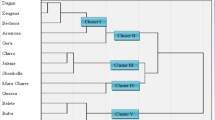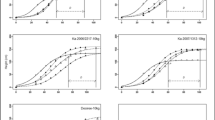Abstract
Potato germplasm was assessed for resistance to corky ringspot disease (CRS) incited by transmission of tobacco rattle virus (TRV). TRV is transmitted by the stubby root nematode,Paratrichodorus allius, in the Pacific Northwest, and characterized by necrotic areas in the tuber. Four tests were conducted at two different problem fields in Umatilla, OR and Pasco, WA. The fields differed in the virulence of the virus isolates. Some clones and named varieties showed resistance only in the field with the relatively mild Umatilla isolate, while others remained symptomless at both sites. The host suitability of test potatoes to threeP. allius populations from the region was determined in greenhouse pot tests, and expressed as reproductive values [Rf = (final population of nematode at 55 days) / (initial population)]. TheR f values for the nematodes were not correlated with resistance ratings based on visual scoring of CRS symptoms in field grown potatoes. Thus, it appears that CRS resistance is based on reaction of potato genotypes to virus and not the vector. The availability of resistant clones inin vitro form is indicated.
Similar content being viewed by others
Literature Cited
Allen, T.C. and J.R. Davis. 1982. Distribution of tobacco rattle virus and potato virus X in leaves, roots, and fruits and/or seeds of naturally-infected weeds. Am Potato J 59:149–153.
Anonymous. 1996. Charakterystyka zrejonizowanych odmian ziemniaka (Characteristics of registered cultivars of potato). Instytut Zemniaka, Wydanie IV. Bonin, Poland.
Banttari, E.E., P.J. Ellis, and S.M.P. Khurana. 1993. Management of diseases caused by viruses and viruslike pathogens, pp. 127–133.In: R.C. Rowe (ed.) Potato health management. Am Phytopathol Soc Press, St. Paul, MN.
Cooper, J.I. and P.R. Thomas. 1971. Chemical treatment of soil to prevent transmission of tobacco rattle virus to potatoes byTrichodorus spp. Ann Appl Biol 69:23–34.
Crosslin, J.M. and P.E. Thomas. 1995. Detection of tobacco rattle virus in tubers exhibiting symptoms of corky ringspot by polymerase chain reaction. Am Potato J 72:605–609.
Crosslin, J.M., P.E. Thomas, and C.R. Brown. 1999. Distribution of tobacco rattle virus in tubers of resistant and susceptible potatoes and systemic movement of virus into daughter tubers. Am Journal of Potato Research 76:191–197.
Dale, M.F.B. 1989. Advances in breeding for tobacco rattle virus insensitivity in potatoes. Aspects of Applied Biology 22:87–92.
Dale, M.F.B. and R.M. Solomon. 1988a. Inheritance of insensitivity to tobacco rattle virus in potatoes. Ann Appl Biol 113:313–318.
Dale, M.F.B. and R.M. Solomon. 1988b. A glasshouse test to assess the sensitivity of potato cultivars to tobacco rattle virus. Ann Appl Biol 112:225–229.
Hooker, W.J. 1981. Compendium of potato diseases. Am Phytopathol Soc Press. St. Paul, MN.
Jenkins, W.R. 1964. A rapid centrifugal-flotation technique for separating nematodes from soil. Plant Disease Reporter 48:692.
Jensen, H.J., P.A. Koepsell, and T.C. Allen. 1974. Tobacco rattle virus and nematode vectors in Oregon. Plant Disease Reporter 58:269–271.
Locatelli, E.A., T.C. Allen, P.A. Koepsell, and A.P. Appleby. 1978. Diagnosis of tobacco rattle virus (TRV) and other viruses in weed and rotation crops in potato fields. Am Potato J 55:249–257.
Maas, P.W. Th. 1975. Soil fumigation and crop rotation to control spraing disease in potatoes. Neth J P1 Path 81:138–143.
Mojtahedi, H. and G.S. Santo. 1999. Ecology ofParatrichodorus allius and its relationship to the corky ringspot disease of potato in the Pacific Northwest. American Journal of Potato Research. (In Press).
Steel, R.D. and J.H. Torrie, 1980. Principles and procedures of statistics: A biometrical approach. McGraw-Hill Book Co. New York, NY, USA. 633 pp.
Weingartner, D.P. and J.R. Shumaker. 1990a Effects of soil fumigants and aldicarb on corky ringspot disease and Trichodorid nematodes in potato. Journal of Nematology 22:665–671.
Weingartner, D.P., and J.R. Shumaker. 1990b. Effects of soil fumigants and aldicarb on nematodes, tuber quality, and yield of potato. Journal of Nematology 22:767–774.
Weingartner, D.P. and R. McSorley. 1994. Management of nematodes and soil-borne pathogens in subtropical potato production. Pp. 202–213In: G.V. Zehnder, M.L. Powelson, R.K. Jansson, K.V. Raman (eds.) Advances in potato pest biology and management. American Phytopathological Society Press, St. Paul, MN.
Xenophontos, S., D.J. Robinson, M.F.B. Dale, and D.J.F. Brown. 1998. Evidence for persistent, symptomless infection of some potato cultivars with tobacco rattle virus. Potato Research 41:255–265.
Author information
Authors and Affiliations
Corresponding author
Rights and permissions
About this article
Cite this article
Brown, C.R., Mojtahedi, H., Santo, G.S. et al. Potato germplasm resistant to corky ringspot disease. Am. J. Pot Res 77, 23–27 (2000). https://doi.org/10.1007/BF02853658
Accepted:
Issue Date:
DOI: https://doi.org/10.1007/BF02853658




